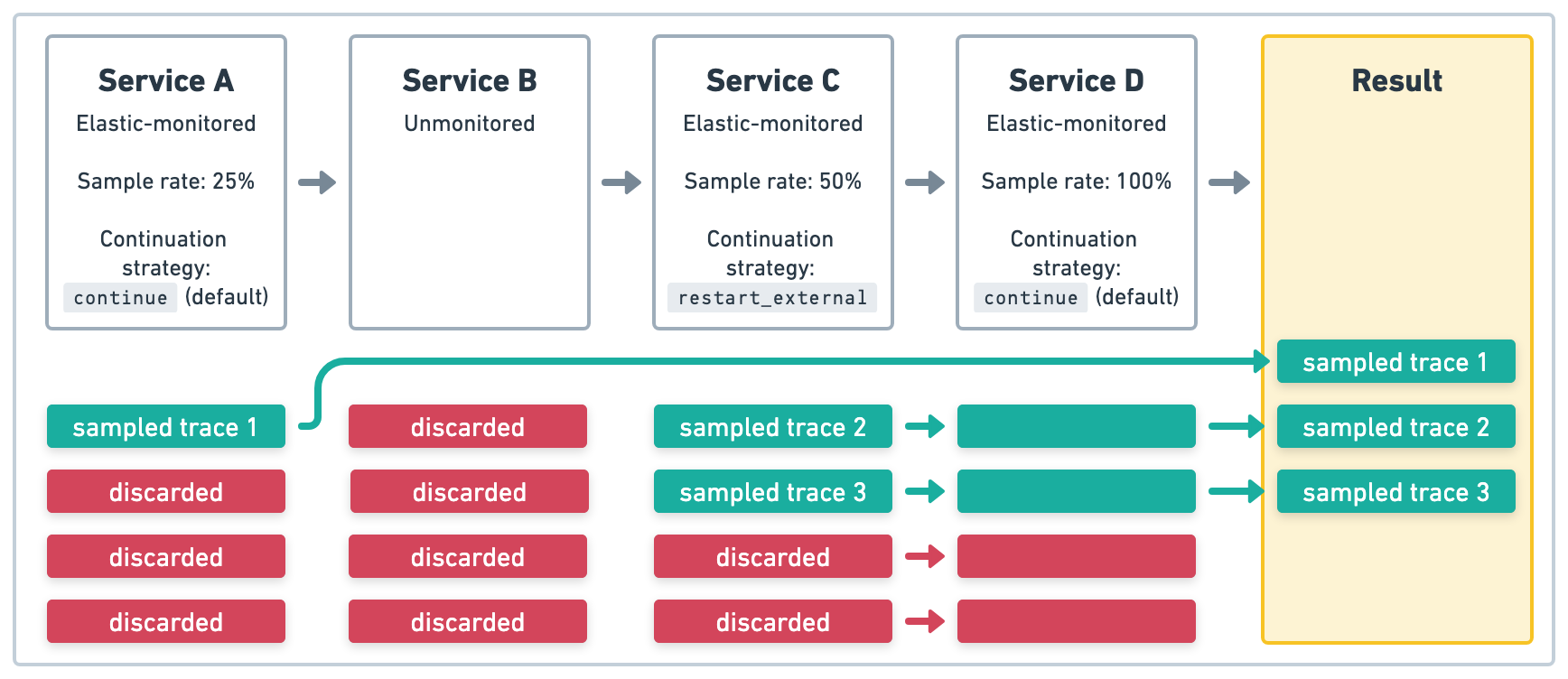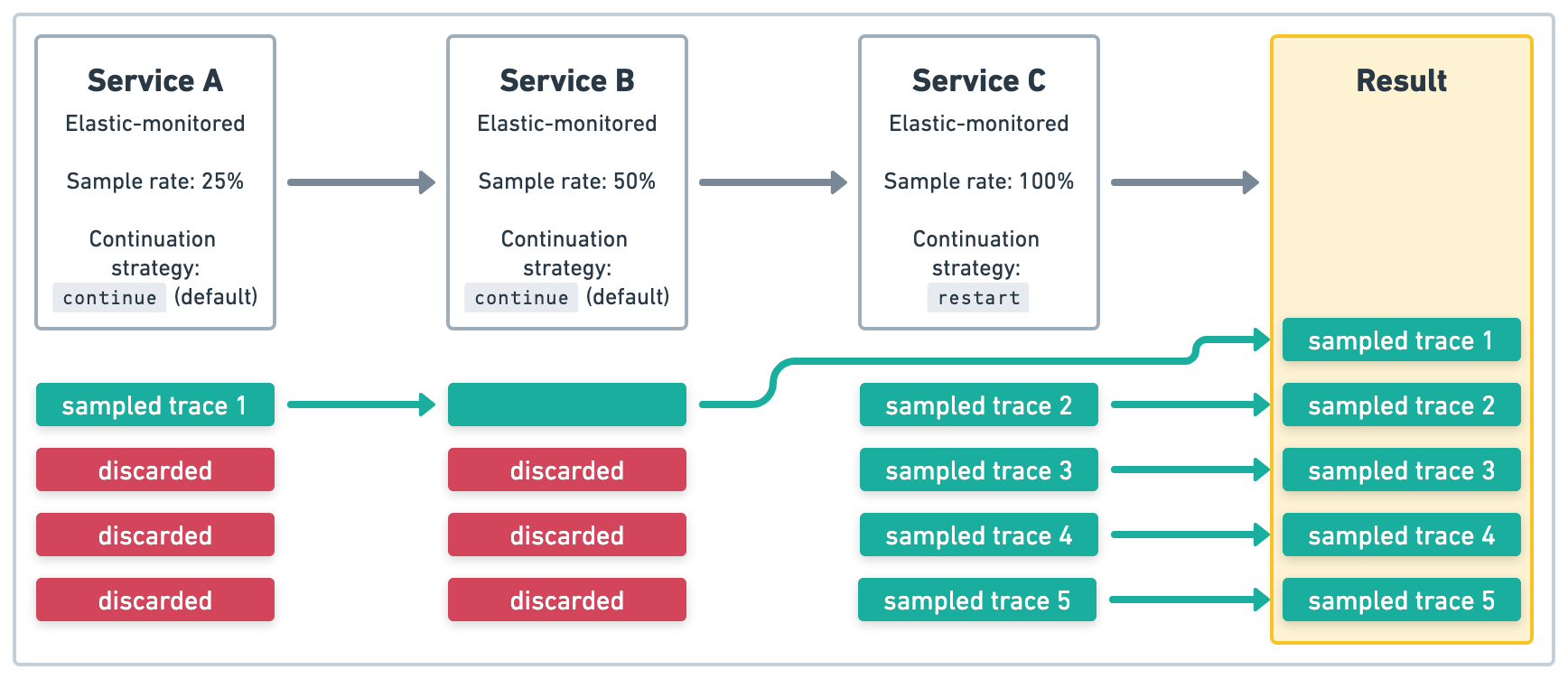- Elastic Cloud Serverless
- Elasticsearch
- Elastic Observability
- Get started
- Observability overview
- Elastic Observability Serverless billing dimensions
- Create an Observability project
- Quickstart: Monitor hosts with Elastic Agent
- Quickstart: Monitor your Kubernetes cluster with Elastic Agent
- Quickstart: Monitor hosts with OpenTelemetry
- Quickstart: Unified Kubernetes Observability with Elastic Distributions of OpenTelemetry (EDOT)
- Quickstart: Collect data with AWS Firehose
- Get started with dashboards
- Applications and services
- Application performance monitoring (APM)
- Get started with traces and APM
- Learn about data types
- Collect application data
- View and analyze data
- Act on data
- Use APM securely
- Reduce storage
- Managed intake service event API
- Troubleshooting
- Synthetic monitoring
- Get started
- Scripting browser monitors
- Configure lightweight monitors
- Manage monitors
- Work with params and secrets
- Analyze monitor data
- Monitor resources on private networks
- Use the CLI
- Configure a Synthetics project
- Multifactor Authentication for browser monitors
- Configure Synthetics settings
- Grant users access to secured resources
- Manage data retention
- Scale and architect a deployment
- Synthetics Encryption and Security
- Troubleshooting
- Application performance monitoring (APM)
- Infrastructure and hosts
- Logs
- Inventory
- Incident management
- Data set quality
- Observability AI Assistant
- Machine learning
- Reference
- Get started
- Elastic Security
- Elastic Security overview
- Security billing dimensions
- Create a Security project
- Elastic Security requirements
- Elastic Security UI
- AI for Security
- Ingest data
- Configure endpoint protection with Elastic Defend
- Manage Elastic Defend
- Endpoints
- Policies
- Trusted applications
- Event filters
- Host isolation exceptions
- Blocklist
- Optimize Elastic Defend
- Event capture and Elastic Defend
- Endpoint protection rules
- Identify antivirus software on your hosts
- Allowlist Elastic Endpoint in third-party antivirus apps
- Elastic Endpoint self-protection features
- Elastic Endpoint command reference
- Endpoint response actions
- Cloud Security
- Explore your data
- Dashboards
- Detection engine overview
- Rules
- Alerts
- Advanced Entity Analytics
- Investigation tools
- Asset management
- Manage settings
- Troubleshooting
- Manage your project
- Changelog
Transaction sampling
editTransaction sampling
editDistributed tracing can generate a substantial amount of data. More data can mean higher costs and more noise. Sampling aims to lower the amount of data ingested and the effort required to analyze that data — all while still making it easy to find anomalous patterns in your applications, detect outages, track errors, and lower mean time to recovery (MTTR).
Head-based sampling
editIn head-based sampling, the sampling decision for each trace is made when the trace is initiated. Each trace has a defined and equal probability of being sampled.
For example, a sampling value of .2 indicates a transaction sample rate of 20%.
This means that only 20% of traces will send and retain all of their associated information.
The remaining traces will drop contextual information to reduce the transfer and storage size of the trace.
Head-based sampling is quick and easy to set up. Its downside is that it’s entirely random — interesting data might be discarded purely due to chance.
Distributed tracing
editIn a distributed trace, the sampling decision is still made when the trace is initiated. Each subsequent service respects the initial service’s sampling decision, regardless of its configured sample rate; the result is a sampling percentage that matches the initiating service.
In the example in Figure 1, Service A initiates four transactions and has a sample rate of .5 (50%).
The upstream sampling decision is respected, so even if the sample rate is defined and is a different
value in Service B and Service C, the sample rate will be .5 (50%) for all services.
Figure 1. Upstream sampling decision is respected

In the example in Figure 2, Service A initiates four transactions and has a sample rate of 1 (100%).
Again, the upstream sampling decision is respected, so the sample rate for all services will
be 1 (100%).
Figure 2. Upstream sampling decision is respected

Trace continuation strategies with distributed tracing
editIn addition to setting the sample rate, you can also specify which trace continuation strategy to use.
There are three trace continuation strategies: continue, restart, and restart_external.
The continue trace continuation strategy is the default and will behave similar to the examples in
the Distributed tracing section.
Use the restart_external trace continuation strategy on an Elastic-monitored service to start
a new trace if the previous service did not have a traceparent header with es vendor data.
This can be helpful if a transaction includes an Elastic-monitored service that is receiving requests
from an unmonitored service.
In the example in Figure 3, Service A is an Elastic-monitored service that initiates four transactions
with a sample rate of .25 (25%). Because Service B is unmonitored, the traces started in
Service A will end there. Service C is an Elastic-monitored service that initiates four transactions
that start new traces with a new sample rate of .5 (50%). Because Service D is also
Elastic-monitored service, the upstream sampling decision defined in Service C is respected.
The end result will be three sampled traces.
Figure 3. Using the restart_external trace continuation strategy

Use the restart trace continuation strategy on an Elastic-monitored service to start
a new trace regardless of whether the previous service had a traceparent header.
This can be helpful if an Elastic-monitored service is publicly exposed, and you do not
want tracing data to possibly be spoofed by user requests.
In the example in Figure 4, Service A and Service B are Elastic-monitored services that use the
default trace continuation strategy. Service A has a sample rate of .25 (25%), and that
sampling decision is respected in Service B. Service C is an Elastic-monitored service that
uses the restart trace continuation strategy and has a sample rate of 1 (100%).
Because it uses restart, the upstream sample rate is not respected in Service C and all four
traces will be sampled as new traces in Service C. The end result will be five sampled traces.
Figure 4. Using the restart trace continuation strategy

OpenTelemetry
editHead-based sampling is implemented directly in the APM agents and SDKs. The sample rate must be propagated between services and the managed intake service in order to produce accurate metrics.
OpenTelemetry offers multiple samplers. However, most samplers do not propagate the sample rate. This results in inaccurate span-based metrics, like APM throughput, latency, and error metrics.
For accurate span-based metrics when using head-based sampling with OpenTelemetry, you must use a consistent probability sampler. These samplers propagate the sample rate between services and the managed intake service, resulting in accurate metrics.
OpenTelemetry does not offer consistent probability samplers in all languages. Refer to the documentation of your favorite OpenTelemetry agent or SDK for more information.
Sampled data and visualizations
editA sampled trace retains all data associated with it. A non-sampled trace drops all span and transaction data. Regardless of the sampling decision, all traces retain error data.
Some visualizations in the Applications UI, like latency, are powered by aggregated transaction and span metrics. Metrics are based on sampled traces and weighted by the inverse sampling rate. For example, if you sample at 5%, each trace is counted as 20. As a result, as the variance of latency increases, or the sampling rate decreases, your level of error will increase.
Sample rates
editWhat’s the best sampling rate? Unfortunately, there isn’t one.
Sampling is dependent on your data, the throughput of your application, data retention policies, and other factors.
A sampling rate from .1% to 100% would all be considered normal.
You’ll likely decide on a unique sample rate for different scenarios.
Here are some examples:
- Services with considerably more traffic than others might be safe to sample at lower rates
- Routes that are more important than others might be sampled at higher rates
- A production service environment might warrant a higher sampling rate than a development environment
- Failed trace outcomes might be more interesting than successful traces — thus requiring a higher sample rate
Regardless of the above, cost conscious customers are likely to be fine with a lower sample rate.
Configure head-based sampling
editEach APM agent provides a configuration value used to set the transaction sample rate. Refer to the relevant agent’s documentation for more details:
-
Go:
ELASTIC_APM_TRANSACTION_SAMPLE_RATE -
Java:
transaction_sample_rate -
.NET:
TransactionSampleRate -
Node.js:
transactionSampleRate -
PHP:
transaction_sample_rate -
Python:
transaction_sample_rate -
Ruby:
transaction_sample_rate
Each APM agent provides a configuration value used to set the transaction sample rate. Refer to the relevant agent’s documentation for more details:
-
Go:
ELASTIC_APM_TRANSACTION_SAMPLE_RATE -
Java:
transaction_sample_rate -
.NET:
TransactionSampleRate -
Node.js:
transactionSampleRate -
PHP:
transaction_sample_rate -
Python:
transaction_sample_rate -
Ruby:
transaction_sample_rate
On this page